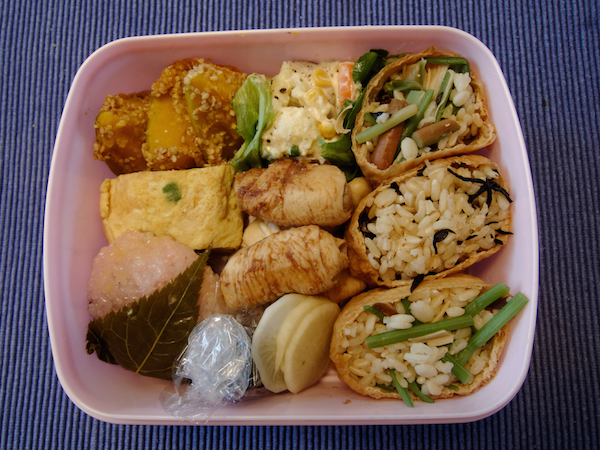One of the things most often noted about Japanese cuisine, is how exquisite it looks. Everything looks so impossibly perfect; small mounds of food look as if they have been sculpted rather than just prepared.
 The colors themselves jump out at you: white, black, green, yellow, and red are artfully positioned in the bento box to resemble something more like a treasure chest than a plate of food. Yet, in such beauty lies a great misunderstanding and seeking the truth will offer new ways to consider how we eat in our own daily lives.
The colors themselves jump out at you: white, black, green, yellow, and red are artfully positioned in the bento box to resemble something more like a treasure chest than a plate of food. Yet, in such beauty lies a great misunderstanding and seeking the truth will offer new ways to consider how we eat in our own daily lives.
 First we must dispel a number of myths. Most important is that Japanese food is not the only beautifully arranged cuisine found in Asia. Consider the signature Korean dish bibimbap (the word literally means “mixed rice”) or the Korean version of sushi, gimbap. Chinese food too tends to be extremely colorful, just consider the endless variety of stir-fries and hot pots.
First we must dispel a number of myths. Most important is that Japanese food is not the only beautifully arranged cuisine found in Asia. Consider the signature Korean dish bibimbap (the word literally means “mixed rice”) or the Korean version of sushi, gimbap. Chinese food too tends to be extremely colorful, just consider the endless variety of stir-fries and hot pots.
One of the common themes that runs through all of these cuisines is the use of color. An ideal meal will always contain five colors: white, black, green, yellow, and red.
Today’s trend to eat colorful meals filled with fruits and vegetables that have been deemed “superfoods” is not the same thing.
The use of five colors in meal preparation has existed for thousands of years. This practice was first recorded in the I-Ching and is connected to the spread of Buddhism from India to China and later from China to the rest of East and Southeast Asia. Buddhist monks not only brought with them the teachings of Buddha but also brought with them advanced techniques in the worlds of science and medicine.
One of the challenges that faced any ancient people was simply surviving. Floods, drought, invasions, and war always made securing food, especially for the lower classes, a great struggle. Buddhist monks and the I-Ching discouraged people facing these challenges from trying to seek out large quantities of food to eat. Instead they promoted things like eating the five colors at each meal, so that even though the meal might not be large, it would be as nutritious as possible.
 For that reason the rules that designate a food to a certain color family are very loose, so they can apply as much as possible to the specific conditions a person is facing, regardless of health, weather, or political upheaval.
For that reason the rules that designate a food to a certain color family are very loose, so they can apply as much as possible to the specific conditions a person is facing, regardless of health, weather, or political upheaval.
White: White/brown rice, tofu, white-fleshed fish, potatoes, turnips, other tubers, certain seeds, and beans.
Black: Soy sauce, dark leafy greens like kale, eggplants, black sesame seeds, shitake mushrooms, blueberries, blackberries, etc.
Red: Red meat, fruits like strawberries, cherries and ruby red grapefruit, and naturally-tinted things like umeboshi pickles, which uses the natural red of the shiso leaf to change the green plum to a pinkish red.
Green: Green also includes hues of blue such as mackerel fish, green beans, peas, soybeans, spinach, cucumbers, etc.
Yellow: Grains such as corn, squash, oranges, eggs, nuts, and pumpkin.
As you can see, the definition of these colors is very basic and does not exclude animal protein. Yet, take note, when foods are processed, like the pickled plums called umeboshi, they fit a category because the coloring is natural, they do not require artificial colors or preservatives. With the coloring, the plums also jump from the green/blue category to red. This clearly illustrates that long before our modern time, we as humans already knew the right way to nourish our bodies.
There is so much more that one could say about the five colors and the I-Ching in regard to food. What I’ve given you is not some new-found trick as to why Asians are so much healthier than Americans – unfortunately today they aren’t, thanks to Western eating habits.
Instead, I’ve offered a brief understanding of the history behind Asian eating habits. More importantly, a reason to pause and consider what is on your own plate at home, without giving in to fads and trends.
Enjoy the five colors of health at every meal, every day.
